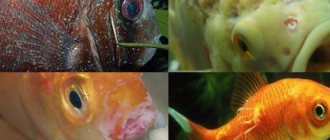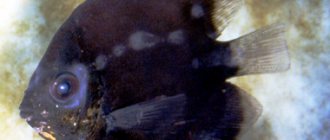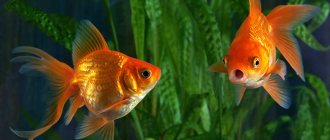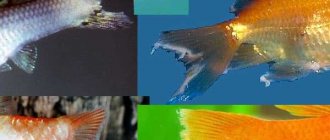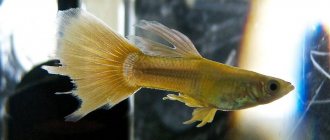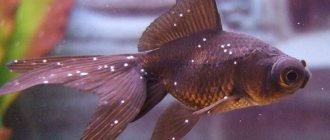Diseases of aquarium fish occur suddenly; modern laboratory diagnostics have learned to recognize most diseases and learn how to treat them. In a home aquarium, in the first days of the onset of the disease, symptoms begin to appear, and the sooner the disease is recognized and treatment begins, the higher the likelihood of success in suppressing the disease.
All diseases of aquarium inhabitants can be divided into three types:
- Infectious in origin, the disease is transmitted from individual to individual.
- Invasive diseases caused by parasites, including unicellular ones.
- Non-communicable diseases that arise as a result of improper care or the influence of large parasites of animal origin.
Causes of diseases
The causes of non-contagious diseases in aquarium fish have different origins.
The main causes of the disease in fish:
- Chemical poisoning;
- Lack of cleaning and aeration equipment;
- Incorrect temperature inside the reservoir.
The chemical nature of the onset of the disease includes chlorine poisoning. Often fish diseases occur in containers without installed aeration equipment. Excessively low and high water temperatures negatively affect the health of individuals. If the temperature is too high, then pets may experience oxygen starvation; a low reading on the thermometer can contribute to the appearance of colds. Invasive diseases caused by viruses and bacteria enter the reservoir in various ways. The danger comes from a new pet, food, substrate, plants and decorative elements.
Care and maintenance
The cleaner catfish rests during the day and works at night. The minimum volume of an aquarium for a pair of fish is 80 liters. For a pair of red ancistrus, a 50 liter jar is suitable. Fish love to dig into the soil, so it should be rounded and small. This could be a mixture of fine gravel or quartz sand. It is better to plant plants in pots.
The aquarium must be equipped with aeration and a powerful filter. In the design, use driftwood, preferably natural, stones, grottoes. For catfish, wood is a source of cellulose. They need it for normal digestion. Once a week you need to siphon the soil and change 1/3 of the aquarium water.
How to correctly diagnose the disease
The disease of fish is primarily manifested by staying in one place for a long time without moving, sinking to the bottom, or hiding under roots and decorative elements. There are many signs of disease in aquarium fish; as a rule, they have an external manifestation.
Sick fish
Signs of an unhealthy state of aquarium fish kept at home:
- Active breathing.
- The appearance of tufts and white spots on the fins.
- Changes in scale color.
- Red thin stripes on transparent fins.
- Changing the degree of pressing of the fins to the body.
- The appearance of a foreign body on the surface of the epidermis.
- The appearance of white dots.
- White round spots of different sizes.
- Abscess formation.
Early diagnosis of the occurrence of a disease in aquarium fish will make it possible to make the correct diagnosis as early as possible, choosing the right treatment and medications.
Reproduction of Ancistrus vulgaris.
These catfish become sexually mature by 1 year, sometimes by 1.5 years. The male has outgrowths on his head similar to branched horns, which in the female are weakly expressed or absent altogether.
To preserve eggs, it is better to breed fish in a spawning tank with a volume of approximately 35-40 liters. To provoke reproduction, you should change some environmental parameters: create good aeration, slightly lower the temperature, replace 1/3 of the water, it is better to feed frozen food in the aquarium, for example, bloodworms, and in the spawning tank only in case of a long delay with plant food. The beginning of breeding can be determined by the behavior of the male; he clears the shelter. The female lays eggs and the male immediately fertilizes them. Next, the female is removed, and the male guards the eggs for about 10 days, until the fry hatch and swim on their own, then the male also needs to be removed. After resorption of the yolk sac, you can feed the fry with small food, sinking granulated food, ground spirulina, and vegetable paste. Fish can be transplanted into a community aquarium at the age of about 4 months, when they reach a size of 3.0-4.5 cm.
How to treat fish
Diseases of aquarium fish are mainly treated using several methods:
- In a common artificial reservoir where pets live.
- Separate containers where fish are placed specifically for medical therapy.
- Individual treatment with lotions.
The most common and effective method is the second, in which the sick individual must be placed in a vessel with a high content of medicinal drug in the liquid. If a fish is diagnosed with a contagious disease or any of its symptoms, then preventive treatment of all aquarium inhabitants should be carried out to prevent mass infection and death.
Therapy of sick individuals in a common vessel is less effective, since the low content of medicinal components in the water does not completely kill the source of the disease. There are frequent cases when a harmful source of disease for aquarium pets persists in the substrate, water, or on the surface of plants, and their treatment gives a short-term result.
Non-communicable diseases
Non-contagious diseases do not pose a danger to the entire aquarium, but require careful treatment to preserve the life of the diseased fish.
Alkalosis or alkaline disease
During alkalosis, the surface of the body becomes dull and loses its shine, and mucus comes out of the gills. The fish moves frantically and tries to jump out of the reservoir. When neglected, clouding of the cornea and blindness occur. Before treating infected fish, they must be moved to another vessel with an acidity level of 7 to 8.5.
Argulez
The cause of argulosis is a parasitic round crustacean, which is visible on the surface of the body of an aquarium fish. The parasite invades the body, destroying the pet’s epidermis and releasing dangerous poison. The fish suffers from severe itching at the injection site. The sick individual must be placed in a fish tank, the parasite must be carefully removed, and the bite site must be treated with an antiseptic.
Asphyxia or suffocation
When individuals are in water poorly saturated with oxygen, they experience suffocation. The gills are open and active breathing movements are noticeable. To cure your pets, it is enough to move them to an oxygen-rich reservoir, then ensure a further supply of high-quality aquarium water. Asphyxia is similar in its symptoms to infectious diseases; if, after moving the fish to a new vessel, their condition does not improve, an infection should be suspected.
Anoxia
Lack of oxygen is a sign of another disease - anoxia; with restless swimming at the surface of the water, one can judge the lack of air inside the aquarium; the disease can also lead to death. For treatment, it is necessary to check the filtration and aeration system and restore the oxygen balance.
Acidemia or ammonia poisoning
The main symptoms of acidemia are darkening of the color and being near the surface, damage to the gills, and attempts to jump out are allowed. For treatment, it is important to change the water and clean the pond.
Acidosis or acid disease
Fish infected with acidosis become pale, inactive and alert, and grayish spots appear on the body. Individuals begin to swim with their belly up and sideways. For treatment, it is necessary to add baking soda to the aquarium to normalize the acidity level of the water.
Inflammation of the gastrointestinal tract
The cause of inflammation of the gastrointestinal tract is a poor and monotonous diet. The main symptom is stool in the form of a thread with mucus and blood, inflammatory processes in the anus. For treatment, you should stop feeding for a few days, then continue to feed with higher quality food.
Gonadal cyst
A sick fish has a swollen belly, in which a tumor forms. The appetite disappears, the individual becomes infertile and dies. There is no treatment as it is not diagnosed in the early stages.
Obesity
Obesity is manifested by bloating, the appearance of fatty tissue on internal organs, and the blood becomes lighter. If the fish is sick, then it will not be possible to cure it; it is recommended to prevent obesity in the aquarium.
Obesity fish
Chlorine poisoning
Poisoned, sick fish are characterized by restless behavior and attempts to jump out of the reservoir. Breathing is difficult and the gills become covered with mucus. Over time, the behavior becomes indifferent and immobile. It is necessary to move all the inhabitants into a new vessel, and purify the low-quality water using a carbon filter.
Gas embolism
The disease occurs as a result of clogging of blood vessels with excessive air. Pets' gills darken and their behavior becomes restless. The best treatment is to create an environment with optimal oxygen levels.
Cold
When individuals are kept at temperatures unacceptable for their species for a long time, the fish become inactive and float on the surface. The color fades and the fins shrink. As a result of decreased immunity, the risk of contracting other infections increases. The water temperature must be increased to the required level.
Mechanical injuries
Injuries occur as a result of fights, aggressive behavior of fish, and poor-quality decorative items inside the reservoir. Major injuries must be treated using potassium permanganate lotions.
Feeding catfish of the species Ancistrus vulgaris
Ancistrus is a herbivore, so food must be of plant origin. Most often, these fish are fed spirulina algae, which is sold in tablet form. Due to the structure of the mouth, catfish eat food from the bottom and, if you add food for catfish along with food for other fish, they can simply eat it and the antsister will not get anything. Therefore, there is a nuance - it is better to feed catfish after the lights are turned off, in the dark, other fish will not be able to interfere with the catfish feeding. In addition to store-bought food, you can feed the ancistrus with pieces of vegetables (cucumber, zucchini, broccoli, etc.). Just remember that such feeding can lead to water spoilage if all food is not carefully removed after feeding.
Contagious diseases
Contagious diseases of aquarium fish are dangerous and life-threatening for the entire aquarium. Contagious diseases are easily transmitted from one aquarium fish to another. To make a diagnosis, you should carefully monitor the external changes of the individual and its behavior.
White-skinned
When infected with this disease, aquarium fish change their appearance. The color becomes lighter, and in some cases turns white. Floating occurs on the surface of the vessel. For treatment, a separate container with chloramphenicol is used.
White-skinned fish
Branchiomycosis
Branchiomycosis appears as dark stripes on the gills. The behavior of the fish becomes inactive, it swims only near the surface of the water, there is no appetite, the individual hides and hunches over, while the fins are pressed. Treatment is carried out in septic tanks using copper sulfate and rivanol.
Hexamitosis
When aquarium fish become infected with this disease, the anus becomes inflamed and erosion of the epidermis appears, which looks like mucous perforated ulcers. The disease is contagious and requires serious long-term drug treatment.
Gyrodactylosis
The main external symptoms of the disease are expressed by pressing the fins. The fish swims near the surface, the movement is rocking, the appetite disappears, the individual rubs against the surface of hard objects, the fins are destroyed. Treatment can be carried out in a common vessel using medications.
Glucose
Affected individuals begin to float on their sides, and growths appear on the skin, which subsequently rupture. The disease is accompanied by bulging eyes. There is no cure; all individuals must be destroyed.
Fin rot
The main symptoms are clouding of the fins, their edges acquire a white-blue tint. Further, the disease is accompanied by rotting of the clouded parts. To treat fin rot, bactericidal medications and baths are used.
Fin rot
Dactylogyrosis
Sick fish move on the surface of the reservoir, the gills become covered with mucus and become of various colors, often the gill filaments grow together. Affected individuals are treated in a common aquarium using bicillin, salt and formalin.
Dermatomycosis or saprolegnia
Often occurs as a secondary disease as a result of weak immunity. The skin and gills are affected, and sometimes internal organs are affected. The fungus is visible in the form of white threads on the epidermis and gills. If dermatomycosis is a primary disease, it is treated with medicinal baths.
Ichthyosporidiosis
Ichthyosporidiosis affects all tissues, with the exception of cartilage and bone tissue. Sick pets move spasmodically, itch, do not eat food, have bulging eyes, and fins are destroyed. No treatment is used. All individuals are destroyed.
Ichthyophthyriosis or decoy spot disease
The main symptoms of semolina include frequent breathing and itching, as a result of which the fish itch on hard surfaces, subsequently white grains similar to semolina appear on the body. For treatment, bactericidal drugs, water changes, and raising the temperature are used.
Lepidorthosis
With lepidorthosis, the scales are raised, as bubbles with liquid inside form under it. As the disease progresses, the scales fall out and the fish dies. It is possible to accurately diagnose the disease only in laboratory conditions. The treatment is effective only at the beginning, when small areas of the body surface are raised.
Trichodinosis
With trichodinosis, fish rub against the substrate and pebbles, and the skin becomes covered with a light-colored coating. The gills change color and become covered with mucus. For treatment, the infected individual is transferred to a tank with a liquid temperature of at least 31 degrees with the addition of salt at the rate of 40 grams per 20 liters.
Peptic ulcer
Accompanying symptoms of ulcers are dark spots on the body that turn into ulcers. But bulging eyes, bloating and lack of appetite also appear. Treatment is necessary immediately, for which streptocide or potassium permanganate is used.
Bug-eyed
With bulging eyes, the eyes become very swollen, and cases of eye loss are common. The disease occurs together with other infectious infections, for example, dropsy. The method of treatment directly depends on this.
Dropsy
Dropsy is manifested by severe bloating of the abdomen, and the scales begin to puff up. The disease is accompanied by shortness of breath and lethargy.
Furunculosis
Furunculosis manifests itself as small dark spots, which over time become red ulcers. Their shape and size are different.
Furunculosis
Plistophorosis
The main sign of infection is a jerky movement upside down. There is no appetite and coordination of movement is impaired. The disease is incurable and therefore requires the destruction of infected individuals.
Mycobacteriosis
Disease of viviparous individuals. Ulcers and abscesses appear, blindness may occur, and the skin may become covered with black dots. Treatment is effective only at an early stage.
Chylodonellosis
Another ailment that affects not only ancistrus, but also all other inhabitants of a freshwater aquarium. At the beginning of the development of this disease, the fish's appetite noticeably decreases. The color of the fish becomes dull, and mobility decreases greatly.
A characteristic sign of the disease will be a compressed, but not frayed, caudal fin. Whitish-bluish areas are often noticeable on the sides and back of the fish. They seem to be a little foggy. All this indicates the beginning of the development of chylodonellosis. Treatment should be started immediately. If the disease develops into a more complex form, the fish will begin to die.
Most often, this disease enters the aquarium along with live food. If you notice that after the temperature drops, the water in the aquarium has become a little cloudy - start taking a closer look at the fish.
The fact is that a temperature of 26 degrees is not very comfortable for this sore. But as soon as the water temperature drops to at least 23-21 degrees Celsius, chilodonella begin to multiply rapidly, and after 2-3 days the entire aquarium will be swarming with this muck. And even if you raise the temperature to 32 degrees, it will be too late.
If earlier we were faced with domestic chilodonella, against which the old-fashioned method of combating temperature was effective, now most often we are dealing with tropical chilodonella. They don’t care about such torture with temperature.
Mild forms of chilodonellosis in a community aquarium are treated by adding drugs such as:
- Sera Omnisan;
- Sera Costapur;
- JBL Punktol;
- Sera Mykopur.
In especially severe cases, treatment should be carried out with Levomycetin from a human pharmacy. Levomycetin tablets are available in 0.5 grams or 0.25 grams. For treatment, it is necessary to dissolve 3 grams of the drug in 100 liters of water. The drug must be applied 2-3 times with a break of 2-3 days. Before each addition of the drug, a third of the water in the aquarium must be replaced with fresh water.
Treatment can be accelerated by raising the water temperature to 28 degrees and pouring 3-4 tablespoons of table salt into the aquarium. This treatment can destroy aquarium plants.
